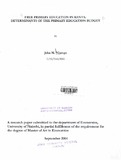| dc.description.abstract | Education in Kenya consists of both formal and non-formal systems. The formal system popularly known as 8.4.4 spans through pre-primary, primary, secondary and university
education. The 8.4.4 system was introduced in 1985 and its main features are eight years of
primary education, four years of secondary education and four years of university education
The study endeavored to analyze the education budget and had the following objectives.
• To establish the main determinants of primary education budget.
• To establish the implications of government education policies on the primary education budget.
• To draw policy recommendations in the light of the research findings.
The study established that education has been a fundamental' strategy for human capital
development and .a crucial vehicle for enhancing the quality of life besides economic
development since 1963. Over the last 34 years, the Government, households, communities and the private investors have striven to enhance the development of education in the country. The efforts of various players in investing in this sector have been guided by the various policy documents such as the Education Act Cap 211 of the laws of Kenya, National Development Plans and Sessional Papers (in particular sessional Papers Nos. 10,6, 1 and 2 of 1965, 1988, 1992 and 1996) respectively. The study also established that the education system has undergone radical changes and various reforms all aimed at accelerating enrolments, retention and completion rates at all levels of education in the country.
The study shows that the government continues to provide and pay teachers in all public primary schools besides meeting other 'administrative costs of the sector. Expenditure on school supplies and equipment had up to the end of 2002 been minimal. These costs including the construction, maintenance of schools and staff houses have been the responsibility of the parents and communities.
Studies cited in the research have shown that there is a lot of inefficiencies in the allocation and utilization of financial, human and materials resources. They have identified the main
costs of primary education all over the world are teacher salaries, .learning and teaching materials and other non wage costs.
The study reports the .main determinants of primary education budget in Kenya as teachers salaries, non wage cost, which includes development- expenditures,• total education budget and to some extent enrolments. It also reveals that the government policies including Free Primary Education and cost sharing policies' are important but no significant determinants of primary education budget.
In conclusion the study found that the continued increase in teachers’ salaries and the low and erratic GDP growth rates are likely to be detrimental to the provision of quality and affordable free primary education. | en |


